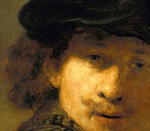
"The Disembowelment of Judas"
While the Gospel of Matthew states, ‘When Judas, the traitor, realized that Jesus had been condemned, Judas was filled with remorse and returned the thirty pieces of silver to the chief priest and the elders, saying ‘I have sinned by betraying innocent blood’ They answered, ‘What does it matter to us? That is your concern.’ So throwing the money into the Temple, he went away and hanged himself.’
Peter in the Acts of the Apostle further states, ‘We know that he brought a field with the reward of his sin; yet he threw himself headlong to his death, his body burst open and all his bowels spilled out. This became known to all the people living in Jerusalem and they named that field Akeldama in their own language, which means Field of Blood.’
Giovanni Canavesio, a master Italian painter of the late 1400’s, was known for his depiction of horrific and violent scenes that were articulated often with a distortion of anatomy. The best rendering of his wacky ways is witnessed by the painting ‘The disembowelment of Judas.’
The scene is set against a walled field titled Akeldama. The berry tree in the field bears not just fruits but also the stain of human blood. A noose hangs loose from the old tree. Against its strings dangles the deranged grotesque figure of Judas, the traitor. A spiky mop of red-hair covers his bestial head.